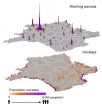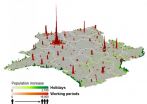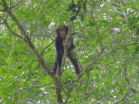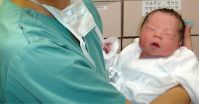(Press-News.org) A study by an international team, including the University of Southampton, has shown population maps based on anonymous mobile phone call record data can be as accurate as those based on censuses.
Their findings show maps made using mobile records are detailed, reliable and flexible enough to help inform infrastructure and emergency planners; particularly in low income countries, where recent population density information is often scarce.
Southampton geographer and senior author on the study, Dr Andy Tatem, says: "Proving the resilience and accuracy of using mobile phone records to map populations was crucial for us, as it has many advantages over traditional census information.
"At the moment mapping of populations is constrained by the logistics of census surveys, which just provide a single snapshot of population distributions every ten years. However, anonymous phone data can be examined regularly to map daily, weekly or monthly changes across an entire country, at less cost and with greater flexibility.
"Every time a person uses a mobile it sends information to a receiving tower and gives an approximate location of where they are. When this information is repeated multiple times, over millions of users, we can extract a detailed picture of population density and how it changes over time in a given area."
The team, led by the Université catholique de Louvain and the Université libre de Bruxelles and working as part of the WorldPop Project and Flowminder Foundation used the anonymised mobile phone records of 19m users in Portugal and France, for several months in 2007 and 2008, to generate maps showing the densities of users in different geographic areas. These maps were found to be as accurate as traditional census-based maps, which the researchers generated from data from the National Institute of Statistics and Economic Studies of France and the National Institute of Statistics of Portugal. Furthermore, by combining the mobile and census information with data from satellite imagery, the spatial resolution and accuracy of the census-based maps was greatly improved.
Dr Tatem comments, "Knowing where people are is critical for accurate impact assessments and intervention planning, particularly for issues such as healthcare, food security, climate change, wars and natural disasters.
"Mobile phone network subscription rates globally are now at 96 per cent and anonymous call record data can give us information from a wide-range of countries – high, middle and low income alike. In particular, it can give us detailed information from regions where census data is either non-existent, outdated or very unreliable."
Dr Tatem and colleagues are already extending their mapping work to low income regions and have used mobile phone-based mobility mapping to help combat malaria more effectively in Namibia. They have improved the targeting of malaria interventions by identifying communities most at risk. Most recently they have used mobile data to help inform authorities tracking and preparing for the spread of Ebola in West Africa.
INFORMATION:
The paper Dynamic Population Mapping Using Mobile Phone Data is published in the journal Proceedings of the National Academy of Sciences and can be found at: http://www.pnas.org/content/early/2014/10/23/1408439111.abstract
A video demonstrating the findings of this paper can be found at http://www.youtube.com/watch?v=qsUDH5dUnvY&feature=youtu.be
Researchers prove accuracy of mobile phone population mapping
2014-10-28
ELSE PRESS RELEASES FROM THIS DATE:
Self-reported sleep disturbances are linked to higher risk for Alzheimer's disease in men
2014-10-28
In a new study, researchers from Uppsala University demonstrate that elderly men with self-reported sleep disturbances run a higher risk of developing Alzheimer's disease than men without self-reported sleep disturbances. The results are published in the scientific journal Alzheimer's & Dementia.
The researchers followed more than 1,000 men, who were initially 50 year old, between the years 1970 and 2010. The results of the study show that self-reported sleep disturbances were linked to an increased risk for Alzheimer's disease during the 40-year follow-up period, particularly ...
The early chimp gets the fig
2014-10-28
This news release is available in German.
How do our close relatives, the chimpanzees, acquire sufficient food when times are lean? By studying wild chimpanzees in the Taï National Park in Côte d'Ivoire researchers of the Max Planck Institute for Evolutionary Anthropology in Leipzig, Germany, provide a clear example of how great apes can acquire extra energy needed to maintain large, costly brains. They show that chimpanzees make their sleeping nests more en route to breakfast sites containing fruits that are more competed for by other daytime fruit-eaters ...
Lessons learned from SARS pandemic should inform current contagion protocols
2014-10-28
In 2003, a novel coronavirus caused a pandemic that affected 26 countries. Severe Acute Respiratory Syndrome (SARS) was most prevalent in Asia; the number of cases in Singapore was second only to China.
In an article published in the American Journal of Roentgenology (AJR), a group of radiologists in Singapore outline the ways in which both medical facilities and practitioners there have incorporated lessons learned from the SARS pandemic.
"The pandemic served as a wake-up call for the medical services, which had to respond and reorganize quickly to meet the rapidly ...
Do financial experts make better investments?
2014-10-28
EAST LANSING, Mich. --- Financial experts do not make higher returns on their own investments than untrained investors, according to research by a Michigan State University business scholar.
The first-of-its-kind study analyzed the private portfolios of mutual fund managers and found the managers were surprisingly unsuccessful at outperforming nonprofessional investors. The findings suggest average investors might be better served to handle their own portfolios rather than pay the often-high fees charged by mutual fund managers, said Andrei Simonov, associate professor ...
Identifying the biological clock that governs female fertility
2014-10-28
Researchers at the University of Gothenburg have identified the biological clock that governs female fertility. The discovery represents a major contribution to research aimed at finding medical approaches to treating infertility in women.
Some women can have successful pregnancies at the age of 50, whereas other are unable to get pregnant when they are 30. Researchers are not yet able to fully explain such differences. One factor is that the onset of menopause is influenced by the point at which the uterus runs out of eggs to release.
A recent study at the University ...
New insights into the development of ciliopathies
2014-10-28
"Epithelial cell layers line all of the inner and outer body and organ surfaces in the human body, for example in the lung, intestine, pancreas and in the inner ear," said Moritz Gegg. Cilia – small, hair-like, microtubule-based structures – project from BBs and are precisely positioned on many of these epithelial cells. "Only through this exact positioning can cilia movements be coordinated so precisely that for example mucus can be transported from the lung or sound can be perceived from sensory inner ear hair cells," added Heiko Lickert.
Cilia are anchored ...
Many home blood pressure monitors may be inaccurate
2014-10-28
Philadelphia, PA (October 28, 2014) — Home blood pressure monitors may be inaccurate in up to 15% of patients, according to a study that will be presented at ASN Kidney Week 2014 November 11¬–16 at the Pennsylvania Convention Center in Philadelphia, PA.
Major guidelines recommend home blood pressure monitoring to guide diagnosis and treatment of patients with hypertension; however, little is known about the real-world accuracy of home blood pressure monitors that patients use. Researchers led by Swapnil Hiremath, MD, MPH (Ottawa Hospital and University ...
NUS researchers discover for the first time that a rare bush frog breeds in bamboo
2014-10-28
Researchers from the National University of Singapore (NUS) have discovered a new reproductive mode in frogs and toads - breeding and laying direct developing eggs in live bamboo with narrow openings - which was observed in the white spotted bush frog (Raorchestes chalazodes). This critically endangered frog is currently only one of two species known to adopt this novel reproductive strategy. The findings were published in The Linnean Society of London's Biological Journal of the Linnean Society, in October 2014.
Life history strategies to increase reproductive success ...
Fish 'personality' linked to vulnerability to angling
2014-10-28
Individual differences in moving activity in a novel environment are linked to individual differences in vulnerability to angling, according to an experimental study completed at the University of Eastern Finland and the Finnish Game and Fisheries Research Institute. The study used novel, long-term observations of individual behaviour in groups and authentic angling trials to analyse if behaviours predict the vulnerability to fishing in brown trout reared in traditional and enriched hatchery rearing environments. Based on the results, it can be predicted that fishing modifies ...
When faced with higher prices, swimming is the activity most likely to take a dive
2014-10-28
Experts agree that it's a great way of staying fit and healthy at any age, but when faced with higher prices people are likely to swim less often, while other forms of physical activity such as working out or walking are barely affected.
According to a study by Brunel University London's Health Economics Research Group (HERG), swimming is the individual activity that most people would drop if they faced higher prices.
The study included interviews with 1,683 people, 83% of whom took part in physical activity in some form. It found that people facing 10% higher entry ...





